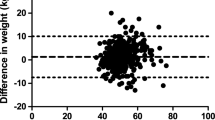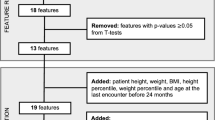Abstract
Background:
It has been known for long time that pregnancy associated with weight problems women but few important factors have been identified, except for weight gain during pregnancy itself.
Objective:
To identify cutoffs for weight gain during pregnancy for identification of women at risk of high weight retention after pregnancy.
Methods:
A longitudinal analysis of 563 women who gave birth in 1984–1985 was used. Weight development during pregnancy was used as diagnostic test for high weight retention at 1 and 15 years follow-up. True positives for high weight retention were defined as >90th percentile at 1 and 15 years. Receiver Operating Characteristic (ROC) analyses were performed to derive cutoffs minimizing the absolute and relative number of misclassifications.
Results:
The average weight retention at 1 year (WR1y) and 15 years (WR15y) was 1.1±3.6 and 7.6±7.4, respectively. There was a moderately strong correlation between weight gain during pregnancy and weight retention at 1 and 15 years follow-up (r2=0.13 and r2=0.05, respectively; both P<0.001) and weight gain during pregnancy as diagnostic test to find high weight retainers performed better than chance both for WR1y (AUC=0.76±0.04, P<0.01) and WR15y (0.63±0.04, P<0.05). To minimize the absolute number of misclassifications of high weight retention, a highly specific and insensitive cut-off of around 24 kg weight gain during pregnancy was needed. The best trade-off between sensitivity and specifity, minimizing the relative number of misclassifications, was at a cutoff of around 16 kg, but this resulted in three times as many absolute misclassifications.
Conclusion:
Weight gain during pregnancy was found to be a moderately strong diagnostic test for weight retention after pregnancy. In order to implement weight gain recommendations for clinical practice larger studies need to be conducted and the demands on the reference values specified, since decisions about the trade-offs between types and extent of misclassifications need to be made.
This is a preview of subscription content, access via your institution
Access options
Subscribe to this journal
Receive 12 print issues and online access
$259.00 per year
only $21.58 per issue
Buy this article
- Purchase on Springer Link
- Instant access to full article PDF
Prices may be subject to local taxes which are calculated during checkout
Similar content being viewed by others
References
Mullins A . Overweight in pregnancy. Lancet 1960; i: 146–147.
Greene J . Clinical stydy of the etiology of obesity. Ann Intern Med 1939; 12: 1797–1803.
Sheldon J . Metarnal obesity. Lancet 1949; ii: 869–873.
Abrams B, Laros R . Prepregnancy weight, weight gain, and birth weight. Am J Obstet Gynecol 1986; 154: 503–509.
Cederlöf R, Kaij L . The effect of childbearing on body weight: a twin control study. Acta Psychiatry Scand Suppl 1970; 219: 47–49.
Forster J, Bloom E, Sorensen G, Jeffery R, Prineas R . Reproductive history and body mass index in black and white women. Prev Med 1986; 15: 685–691.
Smith DE, Lewis CE, Caveny JL, Perkins LL, Burke GL, Bild DE . Longitudinal changes in adiposity associated with pregnancy. The CARDIA Study. Coronary Artery Risk Development in Young Adults Study. Jama 1994; 271: 1747–1751.
Rössner S . Pregnancy, weight cycling and weight gain in obesity. Int J Obes Relat Metab Disord 1992; 16: 145–147.
Dieckman W . The Toxemias of Pregnancy. St Louise: Mosby, 1952.
Instiute of Medicine soDIaNSDP. Committee on Nutritional Status During Pregnancy, weight Gain and Nutrient Supplementd. National Academy Press: Washington DC, 1990.
Öhlin A, Rössner S . Maternal body weight development after pregnancy. Int J Obes Relat Metab Disord 1990; 14: 159–173.
Walker LO . Predictors of weight gain at 6 and 18 months after childbirth: a pilot study. J Obstet Gynecol Neonatal Nurs 1996; 25: 39–48.
Öhlin A, Rössner S . Trends in eating patterns, physical activity and socio-demographic factors in relation to postpartum body weight development. Br J Nutr 1994; 71: 457–470.
Schauberger C, Rooney B, Brimer L . Factors that influence weight loss in the puerperium. Obstet Gynecol 1992; 3: 424–429.
Öhlin A, Rössner S . Factors related to body weight changes during and after pregnancy: the Stockholm Pregnancy and Weight Development Study. Obes Res 1996; 4: 271–276.
Walker LO . Weight and weight-related distress after childbirth: relationships to stress, social support, and depressive symptoms. J Holist Nurs 1997; 15: 389–405.
Parker JD, Abrams B . Differences in postpartum weight retention between black and white mothers. Obstet Gynecol 1993; 81 (Part 1): 768–774.
Gunderson E, Abrams B, Selvin S . Does the pattern of postpartum weight change differ according to pregravida body size? Int J Obes Relat Metab Disord 2002; 25: 853–862.
Edwards LE, Hellerstedt WL, Alton IR, Story M, Himes JH . Pregnancy complications and birth outcomes in obese and normal-weight women: effects of gestational weight change. Obstet Gynecol 1996; 87: 389–394.
Janney CA, Zhang D, Sowers M . Lactation and weight retention. Am J Clin Nutr 1997; 66: 1116–1124.
Dewey KG, Heinig MJ, Nommsen LA . Maternal weight-loss patterns during prolonged lactation. Am J Clin Nutr 1993; 58: 162–166.
Greene GW, Smiciklas-Wright H, Scholl TO, Karp RJ . Postpartum weight change: how much of the weight gained in pregnancy will be lost after delivery? Obstet Gynecol 1988; 71: 701–707.
Linné Y, Barkeling B, Rössner S . Long-term weight development after pregnancy. Obes Rev 2002; 3: 75–83.
Schnell R . Graphisch gestutzte Datenanalyse. Munchen: Oldenbourg Verlag, 1994.
Zweig MH, Campbell G . Receiver-operating characteristic (ROC) plots: a fundamental evaluation tool in clinical medicine. Clin Chem 1993; 39: 561–577.
Hanley JA . The robustness of the ‘binormal’ assumptions used in fitting ROC curves. Med Decision Making 1988; 8: 197–203.
Williamson DF, Madans J, Pamuk E, Flegal KM, Kendrick JS, Serdula MK . A prospective study of childbearing and 10-year weight gain in US white women 25 to 45 years of age. Int J Obes Relat Metab Disord 1994; 18: 561–569.
Linne Y, Dye L, Barkeling B, Rossner S . Weight development over time in parous women-The SPAWN study-15 years follow-up. Int J Obes Relat Metab Disord 2003; 27: 1516–1522.
Thompson ML, Theron GB, Fatti LP . Predictive value of conditional centile charts for weight and fundal height in pregnancy in detecting light for gestational age births. Eur J Obstet Gynecol Reprod Biol 1997; 72: 3–8.
Thompson ML, Fatti LP . Construction of multivariate centile charts for longitudinal measurements. Stat Med 1997; 16: 333–345.
Williams DP, Going SB, Lohman TG, Harsha DW, Srinivasan SR, Webber LS et al. Body fatness and risk for elevated blood pressure, total cholesterol, and serum lipoprotein ratios in children and adolescents. Am J Public Health 1992; 82: 358–363.
Dwyer T, Blizzard CL . Defining obesity in children by biological endpoint rather than population distribution. Int J Obes Relat Metab Disord 1996; 20: 472–480.
Stevens J, Juhaeri, Cai J, Jones DW . The effect of decision rules on the choice of a body mass index cutoff for obesity: examples from African American and white women. Am J Clin Nutr 2002; 75: 986–992.
Linne Y, Barkeling B, Rossner S . Long-term weight development after pregnancy. Obes Rev 2002; 3: 75–83.
Rossner S, Ohlin A . Pregnancy as a risk factor for obesity: lessons from the Stockholm Pregnancy and Weight Development Study. Obes Res 1995; 3 (Suppl 2): 267s–275s.
Barker DJ, Godfrey KM, Osmond C, Bull A . The relation of fetal length, ponderal index and head circumference to blood pressure and the risk of hypertension in adult life. Paediatr Perinat Epidemiol 1992; 6: 35–44.
Wadsworth ME, Kuh DJ . Childhood influences on adult health: a review of recent work from the British 1946 national birth cohort study, the MRC National Survey of Health and Development. Paediatr Perinat Epidemiol 1997; 11: 2–20.
Baker HW . Reproductive effects of nontesticular illness. Endocrinol Metab Clin North Am 1998; 27: 831–850.
Wadsworth M, Rodgers B . Longterm follow-up studies; a critical overwiew. Rev Epidemiol Sante Publique 1989; 37: 533–547.
Stunkard A, Sorensen T . Obesity and socioeconomic status: a complex relation. N Engl J Med 1993; 329: 1036–1037.
Author information
Authors and Affiliations
Corresponding author
Rights and permissions
About this article
Cite this article
Linné, Y., Neovius, M. Identification of women at risk of adverse weight development following pregnancy. Int J Obes 30, 1234–1239 (2006). https://doi.org/10.1038/sj.ijo.0803258
Received:
Revised:
Accepted:
Published:
Issue Date:
DOI: https://doi.org/10.1038/sj.ijo.0803258
Keywords
This article is cited by
-
Physical activity and exercise during pregnancy in Africa: a review of the literature
BMC Pregnancy and Childbirth (2020)
-
Weighing as part of your care: a feasibility study exploring the re-introduction of weight measurements during pregnancy as part of routine antenatal care
BMC Pregnancy and Childbirth (2020)
-
Gestational Weight Gain: Update on Outcomes and Interventions
Current Diabetes Reports (2020)
-
Problems recruiting and retaining postnatal women to a pilot randomised controlled trial of a web-delivered weight loss intervention
BMC Research Notes (2018)
-
A preliminary study on the pattern of weight change from pregnancy to 6 months postpartum: a latent growth model approach
International Journal of Obesity (2011)



